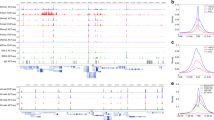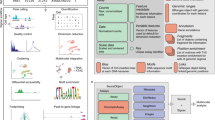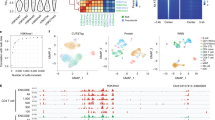Abstract
Protein accumulation on chromatin has traditionally been studied using immunofluorescence microscopy or biochemical cellular fractionation followed by western immunoblot analysis. As a way to improve the reproducibility of this kind of analysis, to make it easier to quantify and to allow a streamlined application in high-throughput screens, we recently combined a classical immunofluorescence microscopy detection technique with flow cytometry. In addition to the features described above, and by combining it with detection of both DNA content and DNA replication, this method allows unequivocal and direct assignment of cell cycle distribution of protein association to chromatin without the need for cell culture synchronization. Furthermore, it is relatively quick (takes no more than a working day from sample collection to quantification), requires less starting material compared with standard biochemical fractionation methods and overcomes the need for flat, adherent cell types that are required for immunofluorescence microscopy.
This is a preview of subscription content, access via your institution
Access options
Subscribe to this journal
Receive 12 print issues and online access
$259.00 per year
only $21.58 per issue
Buy this article
- Purchase on Springer Link
- Instant access to full article PDF
Prices may be subject to local taxes which are calculated during checkout




Similar content being viewed by others
References
Polo, S.E. & Jackson, S.P. Dynamics of DNA damage response proteins at DNA breaks: a focus on protein modifications. Genes Dev. 25, 409–433 (2011).
Prasanth, S.G., Méndez, J., Prasanth, K.V. & Stillman, B. Dynamics of pre-replication complex proteins during the cell division cycle. Philos. Trans. R. Soc. Lond., B Biol. Sci. 359, 7–16 (2004).
Mailand, N., Gibbs-Seymour, I. & Bekker-Jensen, S. Regulation of PCNA-protein interactions for genome stability. Nat. Rev. Mol. Cell Biol. 14, 269–282 (2013).
Zou, Y., Liu, Y., Wu, X. & Shell, S.M. Functions of human replication protein A (RPA): from DNA replication to DNA damage and stress responses. J. Cell. Physiol. 208, 267–273 (2006).
Toledo, L.I. et al. ATR prohibits replication catastrophe by preventing global exhaustion of RPA. Cell 155, 1088–1103 (2013).
Todorov, I.T., Attaran, A. & Kearsey, S.E. BM28, a human member of the MCM2-3-5 family, is displaced from chromatin during DNA replication. J. Cell. Biol. 129, 1433–1445 (1995).
Forment, J.V., Walker, R.V. & Jackson, S.P. A high-throughput, flow cytometry-based method to quantify DNA-end resection in mammalian cells. Cytometry A 81, 922–928 (2012).
Landberg, G., Tan, E.M. & Roos, G. Flow cytometric multiparameter analysis of proliferating cell nuclear antigen/cyclin and Ki-67 antigen: a new view of the cell cycle. Exp. Cell Res. 187, 111–118 (1990).
Huertas, P. DNA resection in eukaryotes: deciding how to fix the break. Nat. Struct. Mol. Biol. 17, 11–16 (2010).
Lecona, E. & Fernández-Capetillo, O. Replication stress and cancer: it takes two to tango. Exp. Cell Res. 329, 26–34 (2014).
Macheret, M. & Halazonetis, T.D. DNA replication stress as a hallmark of cancer. Annu. Rev. Pathol. 10, 425–448 (2015).
Sartori, A.A. et al. Human CtIP promotes DNA end resection. Nature 450, 509–514 (2007).
Darzynkiewicz, Z. et al. DNA damage signaling assessed in individual cells in relation to the cell cycle phase and induction of apoptosis. Crit. Rev. Clin. Lab. Sci. 49, 199–217 (2012).
Neelsen, K.J. et al. Deregulated origin licensing leads to chromosomal breaks by rereplication of a gapped DNA template. Genes Dev. 27, 2537–2542 (2013).
Escribano-Diaz, C. et al. A cell cycle-dependent regulatory circuit composed of 53BP1-RIF1 and BRCA1-CtIP controls DNA repair pathway choice. Mol. Cell 49, 872–883 (2013).
Kotov, I.N. et al. Whole genome RNAi screens reveal a critical role of REV3 in coping with replication stress. Mol. Oncol. 8, 1747–1759 (2014).
Soni, A. et al. Requirement for Parp-1 and DNA ligases 1 or 3 but not of Xrcc1 in chromosomal translocation formation by backup end joining. Nucleic Acids Res. 42, 6380–6392 (2014).
Nishi, R. et al. Systematic characterization of deubiquitylating enzymes for roles in maintaining genome integrity. Nat. Cell Biol. 16, 1016–1026 (2014).
Shibata, A. et al. Factors determining DNA double-strand break repair pathway choice in G2 phase. EMBO J. 30, 1079–1092 (2011).
Shibata, A. et al. DNA double-strand break repair pathway choice is directed by distinct MRE11 nuclease activities. Mol. Cell 53, 7–18 (2014).
Davies, O.R. et al. CtIP tetramer assembly is required for DNA-end resection and repair. Nat. Struct. Mol. Biol. 22, 150–157 (2015).
Britton, S., Coates, J. & Jackson, S.P. A new method for high-resolution imaging of Ku foci to decipher mechanisms of DNA double-strand break repair. J. Cell Biol. 202, 579–595 (2013).
Doudna, J.A. & Charpentier, E. Genome editing. The new frontier of genome engineering with CRISPR-Cas9. Science 346, 1258096 (2014).
Bourton, E.C. et al. Multispectral imaging flow cytometry reveals distinct frequencies of γ-H2AX foci induction in DNA double strand break repair defective human cell lines. Cytometry A 81, 130–137 (2012).
Barteneva, N.S., Fasler-Kan, E. & Vorobjev, I.A. Imaging flow cytometry: coping with heterogeneity in biological systems. J. Histochem. Cytochem. 60, 723–733 (2012).
Polo, S.E. et al. Regulation of DNA-end resection by hnRNPU-like proteins promotes DNA double-strand break signaling and repair. Mol. Cell 45, 505–516 (2012).
Salic, A. & Mitchison, T.J. A chemical method for fast and sensitive detection of DNA synthesis in vivo. Proc. Natl. Acad. Sci. USA 105, 2415–2420 (2008).
Cappella, P., Gasparri, F., Pulici, M. & Moll, J. A novel method based on click chemistry, which overcomes limitations of cell cycle analysis by classical determination of BrdU incorporation, allowing multiplex antibody staining. Cytometry A 73, 626–636 (2008).
Kouzarides, T. Chromatin modifications and their function. Cell 128, 693–705 (2007).
Kurose, A. et al. Assessment of ATM phosphorylation on Ser-1981 induced by DNA topoisomerase I and II inhibitors in relation to Ser-139-histone H2AX phosphorylation, cell cycle phase, and apoptosis. Cytometry A 68, 1–9 (2005).
Hong, V., Steinmetz, N.F., Manchester, M. & Finn, M.G. Labeling live cells by copper-catalyzed alkyne–azide click chemistry. Bioconjug. Chem. 21, 1912–1916 (2010).
Uttamapinant, C. et al. Fast, cell-compatible click chemistry with copper-chelating azides for biomolecular labeling. Angew. Chem. Int. Ed. Engl. 51, 5852–5856 (2012).
Acknowledgements
We thank all members of the Jackson laboratory for helpful discussions. We thank especially A. Blackford, G. Balmus, K. Dry, D.Weismann, C. Schmidt and P. Marco-Casanova for critical reading of the manuscript. Research in our laboratory was funded by Cancer Research UK (CRUK; programme grant C6/A11224), the European Research Council and the European Community Seventh Framework Programme (grant agreement no. HEALTH-F2-2010-259893 (DDResponse)). Core funding was provided by Cancer Research UK (C6946/A14492) and the Wellcome Trust (WT092096). J.V.F. is funded by CRUK programme grant C6/A11224 and the Ataxia Telangiectasia Society. S.P.J. receives his salary from the University of Cambridge, supplemented by CRUK.
Author information
Authors and Affiliations
Contributions
J.V.F. conceived and developed the protocol. J.V.F. and S.P.J. wrote the manuscript.
Corresponding author
Ethics declarations
Competing interests
The authors declare no competing financial interests.
Integrated supplementary information
Supplementary information
Supplementary Text and Figures
Supplementary Figure 1 (PDF 178 kb)
Rights and permissions
About this article
Cite this article
Forment, J., Jackson, S. A flow cytometry–based method to simplify the analysis and quantification of protein association to chromatin in mammalian cells. Nat Protoc 10, 1297–1307 (2015). https://doi.org/10.1038/nprot.2015.066
Published:
Issue Date:
DOI: https://doi.org/10.1038/nprot.2015.066
This article is cited by
-
A clinically relevant heterozygous ATR mutation sensitizes colorectal cancer cells to replication stress
Scientific Reports (2022)
-
Histone chaperone FACT is essential to overcome replication stress in mammalian cells
Oncogene (2020)
-
MRE11-RAD50-NBS1 promotes Fanconi Anemia R-loop suppression at transcription–replication conflicts
Nature Communications (2019)
-
Targeting actin inhibits repair of doxorubicin-induced DNA damage: a novel therapeutic approach for combination therapy
Cell Death & Disease (2019)
-
Map of synthetic rescue interactions for the Fanconi anemia DNA repair pathway identifies USP48
Nature Communications (2018)
Comments
By submitting a comment you agree to abide by our Terms and Community Guidelines. If you find something abusive or that does not comply with our terms or guidelines please flag it as inappropriate.



